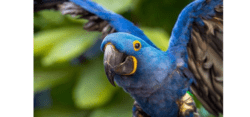Did you know that hyacinth macaws have beaks specially designed for cracking the hardest nuts in the world?
Hyacinth macaws are one of the largest species of parrot. They are beautiful, smart, and can even mimic human speech. They have a blue body of feathers, a solid black beak, and yellow circling their eyes and the lower part of their beak.
They nest in pre-existing holes in trees with a clutch of two to three eggs. Chicks stay with the mother until they are six months old. Macaws have four toes—two toes face forward and two face backward. These feet are called zygodactyl, and are great for perching on branches, climbing in trees, and even holding food.
Parrots use vocalizations to keep in constant contact with one another in their habitat, even if they are on opposite sides of the forest. They have a very loud call, called a contact call, they use for this. It’s their way of saying, “Hey, I’m in a tree over here! Where are you?”
These birds are often kept as pets. Parrots can be challenging to live with, because they haven’t been domesticated for thousands of years the way dogs and cats have. They are still wild animals and have adaptations that allow them to live in the wild.
Learn more about the hyacinth macaw!




